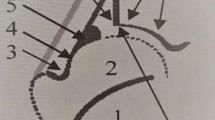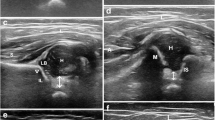Summary
A new technique for ultrasonic examination of the hip is aimed at identification of the acetabular cartilaginous ridge, called the “neolimbus” by Ortolani. The presence of this ridge is pathognomonic for congenital hip dysplasia in the newborn. Ultrasonography of 300 normal hips never showed the neolimbus, but it was present in 25 dysplastic hips. Ultrasound examination of the hips of newborn infants can therefore be combined with the Ortolani test in the very early diagnosis of hip dysplasia.
Résumé
Description d'une nouvelle technique échographique d'exploration de la hanche, méthode élective de détection de la crête cartilagineuse acétabulaire qu'Ortolani appelle “néolimbus”, pathognomonique de la dysplasie congénitale du nouveau-né. Cette technique a été utilisée pour analyser trois cents hanches normales et vingt-cinq hanches dysplasiques de nouveau-nés soumis à notre évaluation. Dans les cas de dysplasie, le diagnostic clinique avait toujours été préalablement porté grâce à l'observation du signe d'Ortolani. Dans les trois cents hanches normales, l'échographie n'a pas montré la présence de néolimbus, tandis que celui-ci a toujours été observé dans les vingt-cinq hanches dysplasiques. Puisque c'est la présence de ce néolimbus qui détermine la positivité du ressaut d'Ortolani et que cette présence peut être décelée grâce à notre technique échographique, je propose l'utilisation de cette méthode, associée à l'évaluation clinique, pour un diagnostic précoce et correct de la dysplasie congénitale de la hanche.
Similar content being viewed by others
References
Graf R (1980) The diagnosis of congenital hip dislocation by the ultrasonic compound treatment [sic]. Acta Orthop Traumatol Surg 97: 117–133
Harcke HY, Clarke NMP, Myung Soo Lee, Borns PF, Mac Ewans GD (1984) Examination of the infant hip with real-time ultrasonography. J Ultrasound Med 3: 131–137
Le Damany P (1912) La luxation congénitale de la hanche. Alcon, Paris
Motta F, Calori A, Savoldi E, Peretti G, Pietrogrande V (1986) L'utilizzazione dell'ecografia nella diagnosi di displasia congenita dell'anca. Ital J Orthop Traumatol 12: 123–130
Motta F (1986) The use of ultrasonography in the diagnosis of congenital hip dysplasia in the newborn. XVth Symposium of the European Society of Osteoarthrology, Kuopio, Finland. Scand J Rheumatol Suppl 60: 21
Motta F (1987) Ultrasonography in the early diagnosis of congenital dysplasia of the hip. ISCOT Congress, Munich. Book of abstracts, p 278
Ortolani M (1937) Un segno poco noto e la sua importanza per la diagnosi precoce di prelussazione congenita dell'anca. Pediatria 2: 129
Ortolani M (1960) L'anatomia patologica della displasia congenita dell'anca nel feto, nel prematuro e nel neonato. SICOT Congress, New York, pp 108–134
Ponseti I (1978) Morphology of the acetabulum in congenital dislocation of the hip. Js. Bone J Surg 60A: 586–599
Scapinelli R, Ortolani M: La displasia congenita delle anche nell'età pediatrica. Diagnosi e trattamento precoci ed ultraprecoci. SIOT Congress, Bologna, Oct 1972
Author information
Authors and Affiliations
Rights and permissions
About this article
Cite this article
Motta, F. Ultrasonography in the diagnosis of congenital hip dysplasia in the newborn. International Orthopaedics 13, 29–31 (1989). https://doi.org/10.1007/BF00266719
Issue Date:
DOI: https://doi.org/10.1007/BF00266719




